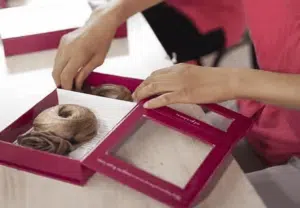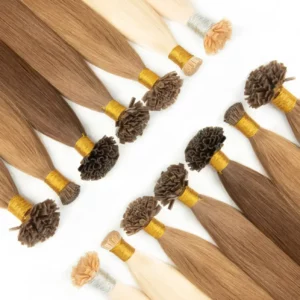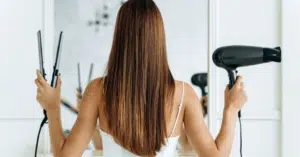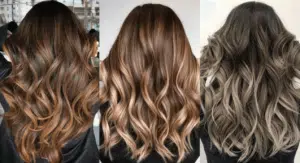If you’ve ever had clients worried about breakage or thinning after wearing extensions, you’re not alone. Damage is a major concern in this industry.what are the least damaging hair extensions?
Hair extensions that are least damaging include halo extensions, clip-in extensions, and properly installed tape-ins. These types apply minimal strain and don’t require heat, glue, or braiding.

Most damage from hair extensions comes from poor installation, excessive weight, or improper removal. Knowing how to choose the right type—and how to install and maintain it—can protect the health of natural hair.
What causes damage from hair extensions?
Most hair extension damage comes from three sources: excessive tension, chemical adhesives, or poor aftercare. Many clients don’t realize the long-term impact until it’s too late.
Hair extensions cause damage when the attachment method puts too much strain on the natural hair. For example, tight sew-in weaves or glued-in tracks can cause tension alopecia, breakage, or balding.
1. Tension
This is the biggest factor in damage. Hair that is pulled too tightly—whether by braids, sew-ins, or keratin bonds—can lead to traction alopecia.
2. Chemicals
Some glues and bonding agents contain harsh ingredients. Over time, these can weaken the hair shaft or irritate the scalp.
3. Improper Maintenance
Hair extensions require care. Without regular detangling, moisturizing, and proper sleeping habits, natural hair can become matted or broken.
| Common Cause | Risk Level | Avoid By |
|---|---|---|
| Tight braids or bonds | High | Looser installs, professional stylists |
| Low-quality adhesives | Medium | Salon-grade tape/glue |
| Not brushing daily | Medium | Use detangling brush and routine |
| Sleeping with wet hair | High | Dry thoroughly before sleep |
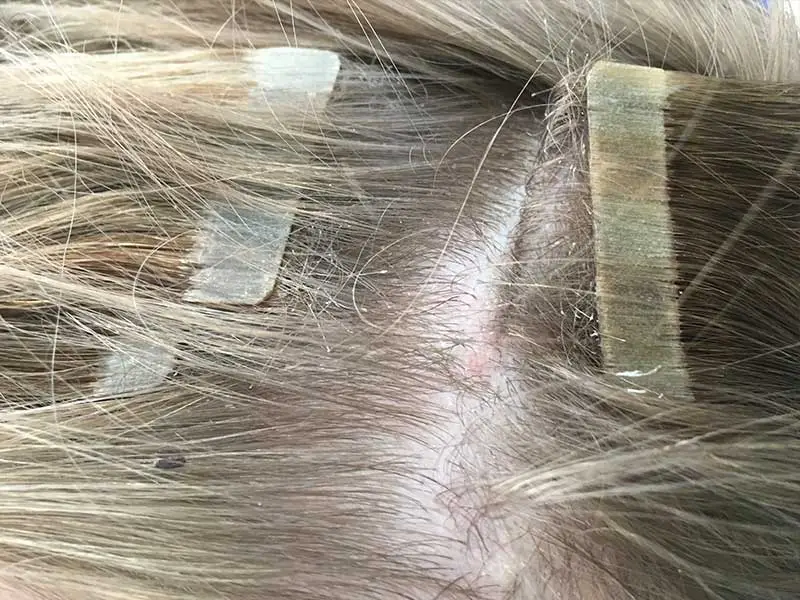
Which hair extension types are the safest?
Many clients assume all extensions cause damage. In reality, it depends on the method and the stylist’s technique.
Halo, clip-in, and hand-tied wefts are the safest methods for most clients. They don’t involve adhesives or heat. When applied professionally and cared for, they can be worn for months with minimal risk.
1. Clip-ins
These are temporary and don’t require glue or braiding. As long as they’re removed before bed, they don’t stress the scalp.

2. Halo Extensions
Halo extensions use a transparent wire that sits gently on the head. No clips, tape, or heat—just easy installation and removal.

3. Tape-ins (professional use)
High-quality tape-ins installed by experienced stylists distribute weight evenly and avoid harsh pulling. They must be removed gently to prevent residue or tugging.

| Method | Tension Level | Installation | Best For |
|---|---|---|---|
| Halo | Low | DIY | Beginners, sensitive scalps |
| Clip-ins | Low | DIY | Everyday, events |
| Tape-ins | Medium | Pro only | Volume + length for daily wear |
How to avoid hair damage from extensions?
Even safe methods can cause problems if not handled properly. Salons should educate clients and train staff to follow best practices.
The best way to avoid damage is to focus on three things: proper installation, client education, and professional removal. When these are followed, damage is nearly zero.
1. Choose lightweight options
Extensions should never outweigh the strength of natural strands. Thin hair needs lighter wefts or tape.
2. Follow proper aftercare
Daily brushing with a loop brush, using silk pillowcases, and avoiding excessive heat will all extend the life of both the extensions and the natural hair.
3. Remove professionally
Glue, tape, or bonds should always be taken out by a trained stylist using the right removers. Never pick or pull.
| Tip | Purpose |
|---|---|
| Sleep in a braid | Prevents tangling |
| Use sulfate-free shampoo | Protects hair and bonds |
| Schedule regular touch-ups | Prevents matting or overgrowth |
What are the early signs of hair damage from extensions?
Sometimes the damage is invisible at first. But small warning signs help you catch problems early.
Scalp tenderness, bumps near the roots, increased shedding, or tangled roots are all red flags. Hair shouldn’t hurt. If a client complains of tightness or pain, it’s time to reassess.
1. Pain or tension at scalp
This is often the first sign. Hair should never feel tight or painful.
2. Shedding when brushing
More than a few strands coming out may indicate too much tension or adhesive pulling on the roots.
3. Matting near roots
This suggests poor aftercare or overdue maintenance.
| Sign | What It Means |
|---|---|
| Headache or sore spots | Extensions are too tight |
| Clumps of hair in brush | Root stress or bond slipping |
| Itchy scalp or flakes | Need for cleansing, lighter install |
My Opinion
At Hibiscus Hair, we’ve spent over a decade working with luxury salons, stylists, and brands. We’ve seen every kind of damage—and how to avoid it. Our full cuticle, ethically sourced hair extensions are designed for long-term health.
We guide all our clients to choose the safest methods, use lightweight hair, and educate their staff. The result: minimal risk, maximum satisfaction.
Whether you’re running a high-end salon or building your hair brand, protecting your clients’ natural hair should always come first. That’s how you build loyalty that lasts.
FAQ: Least Damaging Hair Extensions – Expert Answers
1. Can hair extensions cause permanent damage?
Yes — if applied or removed incorrectly, or worn for prolonged periods without proper care, certain extensions (like bonded or tightly sewn-in types) can lead to long-term damage such as traction alopecia or hair thinning. However, when properly installed, maintained, and removed, extensions do not have to cause permanent damage.
2. Are tape-in extensions safe for thin or fine hair?
Yes — tape-ins are one of the best options for fine hair. Their flat, lightweight structure allows even distribution and low tension on the roots. Just ensure they’re applied professionally with high-quality adhesive and removed with a salon-grade remover to prevent tugging or residue.
3. How often should I give my natural hair a break from extensions?
It’s recommended to give your hair a break every 6–8 weeks between extension cycles. Use this time to deep condition, trim, and restore your natural strands. Regular breaks help prevent long-term stress and maintain healthy hair growth.
4. Are clip-in extensions better than tape-ins in terms of damage?
Clip-ins are generally considered the least damaging because they are temporary and non-adhesive. However, if worn too tightly or pulled out aggressively, they can still cause mechanical stress. Tape-ins, while semi-permanent, distribute weight more evenly and can be safe for regular wear when installed by professionals.
5. What’s the safest way to sleep with extensions in?
Always tie your hair into a loose braid or low ponytail before bed to prevent tangling. Use a silk or satin pillowcase to reduce friction and moisture loss. Never sleep with wet extensions — this can cause matting, breakage, and scalp issues.
6. Can I oil my scalp when wearing extensions?
Yes, but apply oils sparingly. For tape-ins or bonded extensions, avoid direct contact with adhesives, as oils can weaken the bond. Lightweight oils like argan or jojoba can be used on the scalp or ends — just ensure even distribution and avoid buildup.
7. Do all salons follow safe extension practices?
Not all salons are created equal. Always choose a certified stylist with specific experience in extensions. Ask for client before/afters, reviews, and the types of products they use. A well-trained stylist should prioritize scalp health, tension control, and ethical sourcing.
8. How do I know if my extensions are too tight or damaging?
Early signs include:
- Scalp pain or headaches
- Redness or bumps along the hairline
- Excessive shedding at roots
- Difficulty brushing through without snagging
If you notice any of these, consult your stylist immediately. Extensions should feel secure — not painful.
9. Can I reuse tape-in or halo extensions?
Yes — high-quality extensions like full cuticle, Remy hair tape-ins or halo sets can be reused 2–4 times or more with proper care. Regular washing, gentle removal, and re-taping with professional adhesive can extend their lifespan significantly.
10. What’s the biggest mistake clients make with extensions?
One of the most common mistakes is neglecting aftercare — brushing too aggressively, skipping maintenance appointments, using the wrong shampoo, or installing without professional guidance. Extensions are a long-term beauty investment and require commitment to daily care and salon check-ins.
11. Which extension method is best for very active clients (e.g., fitness, swimmers)?
Halo extensions or sewn-in wefts tend to be more secure for active lifestyles. However, tape-ins are also a good semi-permanent option if maintained properly. Always consult your stylist about sweat, chlorine, or salt water exposure, and how to care for extensions post-activity.

Conclusion
The best hair extensions protect natural hair while enhancing beauty. Choose safe methods, work with trained stylists, and never compromise on aftercare.
where to wholesale hair extensions
Hibiscus Hair Manufacturer has been dedicated to producing high-quality hair extensions for 25 years and is a recognized leader in the industry. If you are interested in finding a reliable hair extensions supplier and wholesale for your brand, please visit our website for more information:插入网址 https://www.hibiscushair.com/keratin-hair/i-tip-hair-extensions/
Halo Hair Extensions
CLIP IN HAIR
TAPE IN HAIR

